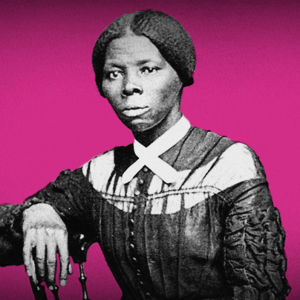
Harriet Tubman was born sometime between 1820 and 1820 in Maryland. She had eight siblings. She was enslaved by age 5, rented out as a domestic servant. Even at an early age she showed resistance to slavery, and at age 12 she intervened when a master was about to beat another slave. She was hit in the head with a two-pound weight, and as a result, she was left with a lifetime of headaches, vivd dreams (that she believed to be visions from God) and narcolepsy.
In 1840, Harriet’s father was set free and she discovered that in their owners’ last will, she, her siblings and her mother had been declared free. However, their new owner refused to acknowledge the will, and they were all kept in slavery.
Despite it being illegal, Tubman married John Tubman, a free black man in 1844. She took his name. The marriage was not a good one however, and her husband tried to sell Harriet in the south. This threat, combined with the knowledge that two of her brothers were also about to be sold, prompted her to come up with an escape plan.
The Underground Railroad was established in the late eighteenth century by black and white abolitionists. Harriet and her two brothers planned to use this network to escape. On September 17 1849 they escaped their Maryland plantation. However, her brothers changed their minds’, and her husband refused to join her on her route, and by 1851 he had married a free black woman. Harriet persevered and travelled 90 miles north to Pennsylvania and to freedom.
She began to work as a housekeeper in Philadelphia, but was not satisfied with her own personal freedom.
She returned to the South and helped dozens of people escape using the Underground Railroad. She was never caught and never lost a passenger. Her successes led slaveowners to put a $40,000 bounty on her head.
She continued to support antislavery campaigns throughout her life, and the knowledge she gained of towns and transportation routes made her a valuable ally of the Union military commanders during the Civil War. She acted as a scout and spy, often disguising herself as an old woman in order to wander the streets of towns under Confederate control, to find out about troop placements and supply lines from the enslaved population. She then helped many of these people find food, shelter and jobs the North. She also worked as a nurse, cook and laundress at Fort Monroe and her knowledge of herbal medicines was vital to help treat injured soldiers.
After the war, she raised funds to aid freedmen, aided in the quest for women’s suffrage and opened a home for the elderly in which she cared for the aged and sick. She married a Union Soldier, also a former slave, and they adopted a daughter.
Her head injury continued to plague her throughout her later life, and she endured brain surgery to attempt to relieve the symptoms. Despite this, her health deteriorated, and she died of pneumonia in 1913. She was buried with military donors in Fort Hill Cemetery in New York.
In 2016, she replaced former President and slaveowner Andrew Jackson on the twenty dollar bill.
